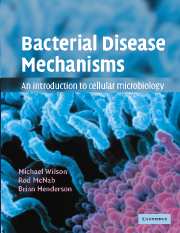Book contents
- Frontmatter
- Contents
- Preface
- Abbreviations used
- Chapter 1 An introduction to bacterial diseases
- Chapter 2 Bacterial cell biology
- Chapter 3 Molecular analysis of bacterial virulence mechanisms
- Chapter 4 Communication in infection
- Chapter 5 The mucosal surface: the front line of antibacterial defence
- Chapter 6 Immune defences against bacteria
- Chapter 7 Bacterial adhesion as a virulence mechanism
- Chapter 8 Bacterial invasion as a virulence mechanism
- Chapter 9 Bacterial exotoxins
- Chapter 10 Bacterial evasion of host defence mechanisms
- Chapter 11 Bacteria in human health and disease: the future?
- Appendix A Glossary of terms used
- Appendix B Brief descriptions of bacteria frequently mentioned
- Index
- Plate section
Chapter 5 - The mucosal surface: the front line of antibacterial defence
Published online by Cambridge University Press: 05 June 2012
- Frontmatter
- Contents
- Preface
- Abbreviations used
- Chapter 1 An introduction to bacterial diseases
- Chapter 2 Bacterial cell biology
- Chapter 3 Molecular analysis of bacterial virulence mechanisms
- Chapter 4 Communication in infection
- Chapter 5 The mucosal surface: the front line of antibacterial defence
- Chapter 6 Immune defences against bacteria
- Chapter 7 Bacterial adhesion as a virulence mechanism
- Chapter 8 Bacterial invasion as a virulence mechanism
- Chapter 9 Bacterial exotoxins
- Chapter 10 Bacterial evasion of host defence mechanisms
- Chapter 11 Bacteria in human health and disease: the future?
- Appendix A Glossary of terms used
- Appendix B Brief descriptions of bacteria frequently mentioned
- Index
- Plate section
Summary
Aims
To introduce the reader to:
the concept of antibacterial defence
the mucosal surfaces of the body
the role of epithelial cells in antibacterial defence
antibacterial biomolecules including antibacterial peptides
the concept of the normal microflora as a defence mechanism
the mucosal epithelium as an antibacterial watchdog for the whole body
Introduction
The planet we live on is alive with unimaginable numbers, and diverse types, of bacteria. It is only possible to give the roughest estimate of how many such species may exist and the figures that are derived are in the range of millions. As described in Chapter 1, our own bodies are not, as we imagine, single organisms, but are colonies containing between 1000 and 3000 (or more) different species of bacteria. Indeed, in the average human body there are approximately 10 bacteria for each human cell. In addition to bacteria, we are also host to a range of viruses, fungi, protozoa and multicellular creatures such as the mites that live on our skin and hair.
Our general view of bacteria as disease-causing organisms is incorrect. This is obvious, given that we normally share our bodies with huge numbers of diverse bacteria. What prevents these astronomical numbers of bacteria from causing disease is not understood. However, it is likely to involve the very complex systems of immunity that mammals have co-evolved with bacteria to enable both types of organism to live in harmony.
- Type
- Chapter
- Information
- Bacterial Disease MechanismsAn Introduction to Cellular Microbiology, pp. 238 - 277Publisher: Cambridge University PressPrint publication year: 2002



